Pumps Are the Heart of Many Water Treatment Devices
Pumps Move Water and Provide Pressure
To Read This Special Pump Edition on our Website.
Pure Water Annie's Practical Guide to Water Treatment Pumps
Let's face it. Pumps aren't the sexiest items in our product catalog. It may be hard to get really worked up about them, but without pumps, water treatment as we know it wouldn't be possible.
Pumps play many roles in water treatment. They move water from one place to another, and they provide added pressure that's sometimes needed to perform treatment functions. Pumps are used to inject water treatment chemicals, to supply compressed air, and to move treated water to its point of use.
Pumps usually rely on electricity for power, but two of the pumps discussed below use the water being treated as their energy source.
The pumps shown below are representative of the many styles of pumps used in standard residential water treatment. We'll explain each as we go.
RO Booster Pump
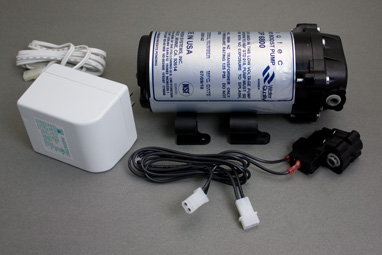 |
The function of the RO booster pump is to increase the pressure of reverse osmosis feed water. Reverse osmosis is a pressure-driven treatment. Increasing the inlet pressure improves both the product/reject efficiency and the quality of the product water (TDS). Conventional residential RO units can run on as little as 40 psi, but they perform with much greater efficiency at 60 psi or above. The pump shown above is an Aquatec 6800. With factory settings, it runs small RO units at around 80 psi inlet pressure regardless of the pressure of the source water. The slightly more powerful Aquatec 8800, which looks identical, is used for RO units with membranes that produce more than 50 gallons per day. The total "pump package," shown above, consists of the pump, the transformer, and a tank pressure switch. For more details about how the pump works, see the Occasional's How It Works entry. For even more information, visit our main website. |
Delivery or "Demand" Pump
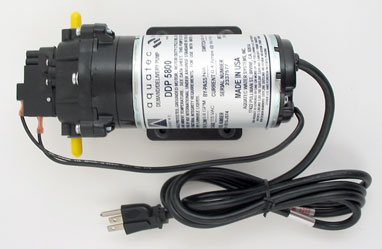 |
The "demand pump" looks much like the booster pump but its function is completely different. Demand or Delivery pumps are used to send water from a low-pressure or no-pressure source to another location. You'll note that there is a pressure switch mounted on the head of the pump. When there is a "demand" for water, like the opening of a valve or a faucet downstream, the pressure on the switch goes down and the switch turns on the pump. When the demand goes away (the faucet is closed), pressure builds in the switch and the switch turns off the pump. This is explained in greater detail on our How It Works page. Small demand pumps are useful tools. Here are some examples of how they are used: To send water at increased pressure from an undersink reverse osmosis unit to a distant refrigerator or icemaker. To send water to an aquarium tank from a storage tank. To send water from a non-pressurized storage tank to the customer's bottle in a water vending machine. The pump above is an Aquatec 5800. Pumps in this category typically deliver water at rates of about 0.5 to 1.5 gallons per minute. Go to our main website (bottom of the page) for more details. |
Repressurization Pump
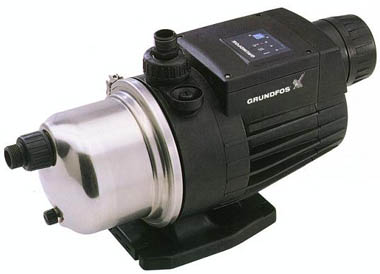 |
The sophisticated one HP Grundfos repressurization pump above is actually in function a much larger version of the small demand pump. It delivers water on demand to homes and other large applications. The quiet, smooth operating pump has its own small built-in pressure tank to assure smooth, instant delivery of water upon demand. It functions without the added pressure tank that is normally used with well pumps. We offer this pump as part of a "whole house option" package that consists of all the parts you need to send water from a non-pressurized reverse osmosis holding tank to the home. When a demand is made for water in the home, the powerful but sensitive variable-speed pump comes on to supply it. |
Chemical Feed or Injection Pump
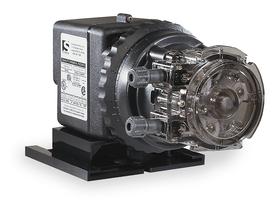 |
The Stenner variable speed injection pump above feeds liquids at a very slow rate but at high pressure into a water pipe. It is used for a variety of purposes. For example: It feeds chlorine to kill bacteria or to oxidize iron or hydrogen sulfide. It feeds soda ash to raise the pH of acidic water. It feeds polyphosphate to "sequester" iron or hardness. It feeds hydrogen peroxide to oxidize hydrogen sulfide or iron. It can also feed combinations of chemicals, making it a very handy tool for treatment of water that has multiple problems. It is unique among the pumps on this page, being a "peristaltic"-style pump that works by squeezing a flexible tube with a roller. (See How It Works on the Occasional's website.) The lowest output Stenner pump that we offer can feed solution at the very slow rate of 0.2 gallons per 24 hours. Pumps of this type are often also called "metering" pumps. For much more information about Stenner injection pumps, see our main website. |
RO Permeate Pump
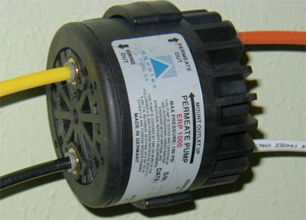 |
The Aquatec Permeate Pump is a unique device that significantly improves the economy and performance of small reverse osmosis units. It functions by storing the hydro power from the RO unit's drain water stream and using this energy to force product water (permeate) into the RO unit's storage tank. It frees the reverse osmosis unit from the need to contend with back pressure from the air-pressurized storage tank. The result is that the RO tank fills faster and the unit uses less drain water and produces better quality water. The permeate pump is one of the most significant improvements in RO technology in recent years. Its cost is modest, and it can be added to most existing RO units. For more information, see How It Works and our main website. |
Water-Driven Injection Pump
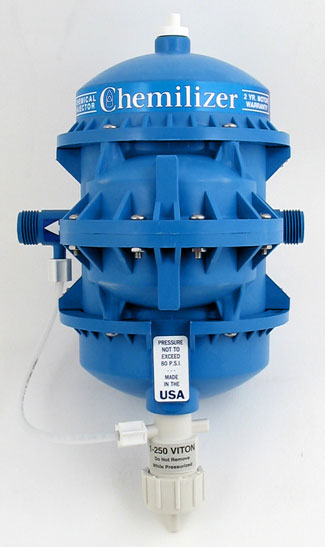 |
The Chemilizer non-electric injection pump feeds solutions of chemicals like chlorine, soda ash, polyphosphate, and hydrogen peroxide into a water stream using only the energy taken from the flowing water itself. It fills many of the functions of the electric Stenner pump shown above, but it requires no electrical connection. The pump in the picture is the small white appendage at the bottom of the large blue "water motor" that supplies the power. As water flows through the blue water motor, the motor turns the pump which picks up the treatment solution from a solution tank below it and pressure-feeds it into the water line. This injection system has the advantage of feeding at varying speeds into a stream of varying flow rates. The faster the water being treated runs, the more of the treatment chemical is injected. This pump is a very fast feeder, injecting at a 250 to 1 ratio. For every 250 gallons of water that passes through the water motor, the pump injects a gallon of solution. This high rate of injection means that most commonly used chemicals, like chlorine, have to be diluted heavily to avoid over treatment, and some very concentrated chemicals, like Spectraguard, just won't work with this pump. |
Air Pump
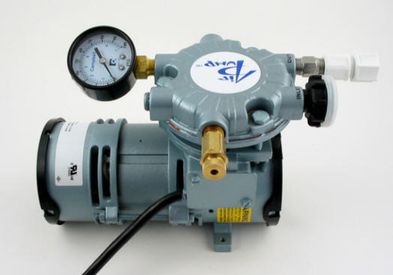 |
The small compressor or air pump injects air into a treatment tank. The water being treated falls into the treatment tank where the compressed air oxidizes the iron and hydrogen sulfide, making them easily removable by the filter that follows. The air pump is quiet, dependable, and economical to operate. You can see How Aeration Works on the Occasional's website, and learn a lot more about how air pumps can be used to treat water on our main website. |
Booster Pump for Larger RO Units
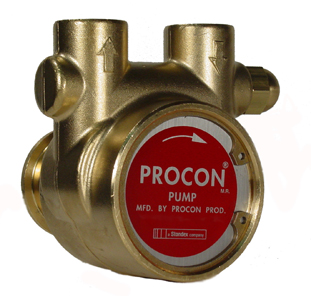 |
The Procon Carbonator Rotary Vane pump attaches to an electric motor (not shown in picture) to provide high pressure water for large reverse osmosis systems like our Watts R-12 Units. The pump can easily run the RO unit at pressures upward of 200 psi.
|
Pure Water Products sells all the pumps above and supplies parts for most.
Please call us if there are questions.
Pure Water Products
940 382 3814